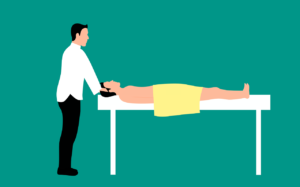
Do you often wake up with a sore neck and shoulders, feeling stiff and uncomfortable? If so, you’re not alone. Many people experience this common issue, which can make daily activities challenging and hinder your overall well-being. Fortunately, there are effective ways to relieve neck and shoulder pain, allowing you to find relief and improve your quality of life. In this article, we will explore simple and practical techniques that can help alleviate your discomfort, so you can start each day feeling refreshed and rejuvenated.

Understanding Neck and Shoulder Pain
Neck and shoulder pain can be a common and frustrating issue that many people experience. It can range from a mild discomfort to debilitating pain, affecting your daily activities and overall quality of life. To effectively manage and alleviate this pain, it is important to understand the underlying causes, the significance of addressing it, and when to seek medical attention.
Common Causes of Neck and Shoulder Pain
Neck and shoulder pain can be caused by various factors, including poor posture, muscle strain, repetitive movements, injuries, and underlying medical conditions. Spending long hours in front of a computer or maintaining improper posture while sleeping can strain the neck and shoulder muscles, leading to pain and discomfort. Additionally, activities such as lifting heavy objects, carrying backpacks, or participating in sports can also contribute to this type of pain.
The Importance of Addressing Neck and Shoulder Pain
Ignoring neck and shoulder pain can have long-term consequences on your overall well-being. Persistent pain can affect your ability to perform daily tasks, work efficiently, and participate in recreational activities. It can also cause headaches, fatigue, and sleep disturbances, impacting your quality of life. Addressing the pain early on can help prevent it from worsening and improve your overall health and productivity.
When to Seek Medical Attention
In most cases, neck and shoulder pain can be relieved through self-care techniques and lifestyle changes. However, certain situations warrant medical attention. If your pain is persistent, severe, or accompanied by other symptoms like numbness, tingling, or limited range of motion, it is essential to consult a healthcare professional. They can diagnose the underlying cause of your pain and recommend appropriate treatment options.
Lifestyle Changes to Relieve Neck and Shoulder Pain
Making certain lifestyle changes can significantly reduce neck and shoulder pain and prevent its recurrence. By incorporating these habits into your daily routine, you can make a positive impact on your overall musculoskeletal health.
Improving Posture and Ergonomics
Maintaining good posture throughout the day is essential for preventing neck and shoulder pain. Whether you are sitting, standing, or walking, ensure that your spine is aligned and your shoulders are relaxed. Using ergonomic chairs, adjustable desks, and proper computer setups can also help maintain correct posture and reduce strain on your neck and shoulders.
Strengthening Neck and Shoulder Muscles
Weak neck and shoulder muscles can contribute to pain and discomfort. Engaging in regular exercises that target these muscles can help strengthen and stabilize them. Simple exercises like neck rotations, shoulder shrugs, and lateral raises can be effective in keeping these muscles strong and healthy.
Maintaining a Healthy Weight
Being overweight or obese can put excessive strain on your neck and shoulder muscles, leading to pain and discomfort. By maintaining a healthy weight through a balanced diet and regular exercise, you can alleviate the pressure on these muscles, reducing the likelihood of pain and improving overall well-being.
Regular Exercise and Stretching
Engaging in regular exercise and stretching can help alleviate and prevent neck and shoulder pain. Low-impact exercises, such as walking, swimming, and cycling, can improve blood circulation and strengthen the muscles in these areas. Additionally, incorporating stretching exercises specific to the neck, shoulders, and upper back can help alleviate muscle tension and improve flexibility.
Avoiding Repetitive Strain
Repetitive strain, such as frequently performing the same motion or using improper form during daily activities, can contribute to neck and shoulder pain. It is important to be mindful of your movements and take breaks when engaging in repetitive tasks. Additionally, using proper body mechanics while lifting heavy objects or participating in physical activities can help prevent strain and subsequent pain.

Self-Care Techniques for Neck and Shoulder Pain Relief
In addition to lifestyle changes, there are various self-care techniques that can provide relief from neck and shoulder pain. These techniques can be easily incorporated into your daily routine and offer immediate relief.
Hot and Cold Therapy
Applying heat or cold to the affected area can help reduce inflammation and alleviate pain. You can use a heating pad, warm towel, or take a warm shower to relax tight muscles. Alternatively, applying an ice pack or bag of frozen peas wrapped in a cloth can help numb the area and reduce swelling. Experimenting with both hot and cold therapies can help determine which method works best for you.
Massage and Self-Massage
Massage therapy is an effective way to relieve neck and shoulder pain. You can visit a professional massage therapist or even perform self-massage techniques at home. Using your hands, a foam roller, or massage balls, gently apply pressure to the affected areas to release muscle tension and promote relaxation. Be sure to use proper techniques and avoid excessive pressure that may cause additional pain.
Topical Pain Relief Products
Over-the-counter topical pain relief products, such as creams, gels, and patches, can provide temporary relief from neck and shoulder pain. These products often contain ingredients like menthol or capsaicin, which create a cooling or warming sensation to distract from the pain. Applying these products as directed can offer immediate relief and allow you to continue with your daily activities.
Using Supportive Pillows and Mattresses
Investing in supportive pillows and mattresses can significantly improve neck and shoulder pain. Pillows designed for proper neck alignment can help maintain a neutral position while sleeping, reducing strain on these areas. Mattresses with adequate support can also alleviate pressure points and promote proper spinal alignment, resulting in less pain and improved sleep quality.
Relaxation and Stress Management Techniques
Neck and shoulder pain can often be exacerbated by stress and tension. Incorporating relaxation techniques into your daily routine, such as deep breathing exercises, meditation, or yoga, can help reduce stress levels and alleviate pain. By managing stress effectively, you can prevent the muscle tension associated with neck and shoulder pain.
Incorporating Healthy Habits into Daily Routine
Maintaining a healthy routine can contribute to overall well-being and minimize the likelihood of experiencing neck and shoulder pain. By making conscious choices and practicing good habits, you can significantly reduce the occurrence and severity of pain.
Ergonomic Workstation Setup
If you have a desk job or spend prolonged periods working on a computer, ensuring an ergonomic workstation setup is crucial. Adjust your chair height, position your monitor at eye level, use a keyboard and mouse that promote neutral wrist positioning, and take regular breaks to avoid muscle stiffness and fatigue.
Taking Regular Breaks
Regardless of your job or daily activities, taking regular breaks is essential for preventing neck and shoulder pain. Get up, stretch, and move around every 30 minutes to relieve muscle tension and improve blood circulation. Incorporating micro-breaks throughout the day can make a significant difference in preventing pain and promoting overall well-being.
Proper Sleeping Positions
Maintaining proper sleeping positions is important for preventing neck and shoulder pain. Sleeping on your back or side with a supportive pillow can help keep your spine aligned and reduce pressure on these areas. Avoid sleeping on your stomach as it can strain your neck and lead to pain and discomfort.
Maintaining a Balanced Diet
Eating a balanced diet can contribute to a healthy weight and reduce inflammation in the body, including the neck and shoulder areas. Incorporate foods rich in antioxidants, omega-3 fatty acids, and vitamins and minerals to support overall musculoskeletal health. Reduce your intake of processed foods and sugary drinks, as they can contribute to inflammation and exacerbate pain.
Hydration and Detoxification
Staying hydrated is essential for maintaining healthy muscles and joints. Drinking an adequate amount of water throughout the day can help flush out toxins, prevent muscle cramps, and keep your body functioning optimally. Additionally, incorporating detoxification practices, such as sauna sessions or gentle cleanses, can further support the body’s natural healing process.

Alternative Treatments for Neck and Shoulder Pain
In addition to lifestyle changes and self-care techniques, alternative treatments can also provide relief for neck and shoulder pain. These treatments focus on holistic approaches that aim to address the root cause of the pain.
Acupuncture and Acupressure
Acupuncture and acupressure involve stimulating specific points on the body to relieve pain and promote healing. These traditional Chinese medicine practices have been found effective in reducing neck and shoulder pain by improving energy flow and releasing tension. Seeking the services of a trained acupuncturist or acupressure practitioner can help alleviate pain and restore balance to your body.
Chiropractic Care
Chiropractic care focuses on restoring proper alignment and mobility in the spine to relieve pain and improve overall health. Chiropractors use manual techniques such as spinal adjustments, joint mobilization, and soft tissue therapy to alleviate neck and shoulder pain. Regular chiropractic visits can help address any underlying misalignments or imbalances contributing to your pain.
Physical Therapy
Physical therapy is often recommended for individuals with persistent neck and shoulder pain. A licensed physical therapist can create a customized treatment plan that includes exercises, stretches, and manual techniques to improve muscle strength, flexibility, and posture. They can also provide guidance on proper body mechanics to prevent future injuries and pain.
Yoga and Pilates
Yoga and Pilates are forms of exercise that focus on strength, flexibility, and body awareness. These practices can be beneficial for individuals experiencing neck and shoulder pain by promoting proper alignment, relieving muscle tension, and improving posture. Attending yoga or Pilates classes taught by qualified instructors can provide guidance and ensure proper technique to prevent further pain.
Herbal Remedies and Supplements
Certain herbal remedies and supplements have been traditionally used to alleviate pain and reduce inflammation. For example, turmeric, ginger, and devil’s claw have anti-inflammatory properties that can help alleviate neck and shoulder pain. However, it is important to consult with a healthcare professional before incorporating any new herbs or supplements into your routine to ensure safety and effectiveness.
Over-the-Counter and Prescription Medications
In some cases, over-the-counter or prescription medications may be necessary to manage severe or chronic neck and shoulder pain. These medications can provide temporary relief and help you carry out daily activities more comfortably.
Non-Steroidal Anti-Inflammatory Drugs (NSAIDs)
Non-steroidal anti-inflammatory drugs, such as ibuprofen or naproxen, can help reduce pain and inflammation in the neck and shoulder area. These medications are available over-the-counter and can provide short-term relief. It is important to follow the recommended dosage and consult with a healthcare professional if you have any underlying medical conditions or are taking other medications.
Muscle Relaxants
Muscle relaxants can be prescribed by a healthcare professional to alleviate muscle spasms and relieve pain. These medications work by reducing muscle tension and promoting relaxation. They are typically used for short-term relief and may cause drowsiness, so it is important to follow the prescribed dosage and avoid driving or operating heavy machinery while taking them.
Pain Relieving Creams and Gels
Topical pain relieving creams and gels can provide localized relief for neck and shoulder pain. These products often contain ingredients like lidocaine or menthol, which temporarily numb the area and reduce pain signals. When using these products, be sure to follow the instructions and avoid applying them to broken or irritated skin.
Prescription Medications for Chronic Pain
For individuals with chronic neck and shoulder pain, prescription medications may be necessary for long-term management. These medications, such as opioids or muscle relaxants, should be prescribed and monitored by a healthcare professional. It is important to discuss potential side effects, risks, and precautions associated with these medications before starting any new prescription.
Potential Side Effects and Precautions
It is important to note that over-the-counter and prescription medications can have potential side effects and precautions. Common side effects include stomach upset, drowsiness, or allergic reactions. Precautions should be taken if you have certain medical conditions, are taking other medications, or are pregnant or breastfeeding. It is always advisable to consult with a healthcare professional before initiating any medication regimen.
Professional Interventions for Severe Neck and Shoulder Pain
For individuals experiencing severe or persistent neck and shoulder pain that does not respond to conservative treatments, professional interventions may be necessary. These interventions are typically reserved for specific cases and require medical expertise.
Cortisone Injections
Cortisone injections, also known as corticosteroid injections, are administered by healthcare professionals to provide targeted pain relief in severe cases. These injections contain a corticosteroid medication that reduces inflammation and alleviates pain. Cortisone injections are often used when other treatments have been unsuccessful, and their effects can last for several weeks to months.
Trigger Point Injections
Trigger point injections are used to treat specific trigger points or knots in the muscles that cause pain. These injections typically contain a local anesthetic or a combination of anesthetics and corticosteroids. By targeting the trigger points directly, healthcare professionals can help relieve muscle tension and reduce pain.
Surgery as a Last Resort
Surgery is typically considered a last resort for severe neck and shoulder pain that does not respond to other treatments. Surgical procedures may involve removing bone spurs, repairing herniated discs, or stabilizing the spine. It is essential to consult with a specialist and thoroughly discuss the risks, benefits, and potential outcomes before considering surgical intervention.
Consulting with Specialists
If your neck and shoulder pain persist despite conservative treatments, it may be necessary to consult with specialists. Orthopedic surgeons, neurologists, or pain management specialists can evaluate your condition, order any necessary tests or imaging, and recommend appropriate treatment options. Seeking specialized care can provide a comprehensive assessment and tailor treatment plans specific to your needs.
Risk Factors and Considerations
Before undergoing professional interventions, it is important to consider the potential risks and benefits. Every intervention carries its own set of risks, including infection, bleeding, or adverse reactions. Furthermore, individual factors, such as age, overall health, and underlying medical conditions, can affect the outcomes of these interventions. Discussing these concerns with your healthcare provider and obtaining a second opinion if necessary can help make informed decisions.
Preventing Future Neck and Shoulder Pain
Prevention is key when it comes to neck and shoulder pain. By incorporating healthy habits and practicing good body mechanics, you can minimize the risk of experiencing pain in the future.
Maintaining Good Posture
Maintaining good posture throughout the day is crucial for preventing neck and shoulder pain. Whether sitting, standing, or walking, focusing on proper alignment and avoiding slouching can reduce tension on these areas. Regularly reminding yourself to check and correct your posture can help make it a habit.
Stress Reduction Techniques
Managing stress effectively is essential for preventing neck and shoulder pain. High levels of stress can cause muscle tension and contribute to pain. Engaging in stress reduction techniques such as meditation, deep breathing exercises, or engaging in hobbies can help minimize stress levels and prevent the onset of pain.
Regular Exercise and Stretching
Engaging in regular exercise and stretching is crucial for maintaining good musculoskeletal health. By incorporating activities that strengthen and stretch your neck and shoulder muscles, you can improve their endurance and flexibility. Regular exercise also helps improve blood circulation and maintain a healthy weight, further reducing the risk of pain.
Using Ergonomic Equipment
Using ergonomic equipment, such as supportive chairs, adjustable desks, and properly positioned computer accessories, can significantly reduce the risk of developing neck and shoulder pain. Invest in furniture and equipment that promote proper posture and body alignment to prevent unnecessary strain on these areas.
Regular Check-ups and Maintenance
Routine check-ups with healthcare professionals, such as chiropractors or physical therapists, can help identify and address any underlying issues that may lead to neck and shoulder pain. These professionals can provide guidance, exercises, and preventive measures that can contribute to long-term musculoskeletal health.
Exercises and Stretches for Neck and Shoulder Pain Relief
Exercises and stretches targeting the neck and shoulder muscles can provide immediate relief and prevent pain from recurring. Incorporating these exercises into your routine can help strengthen and stretch the muscles, reducing tension and promoting overall well-being.
Neck Stretching Exercises
- Neck tilt: Sit or stand tall, gently tilt your head to one side, bringing your ear towards your shoulder. Hold for 15-30 seconds and repeat on the other side.
- Neck rotation: Turn your head to one side, aiming to align your chin with your shoulders. Hold for 15-30 seconds and repeat on the other side.
- Neck flexion and extension: Slowly lower your chin towards your chest to stretch the back of your neck. Then, tilt your head backward to stretch the front of your neck. Hold each position for 15-30 seconds.
Shoulder Strengthening Exercises
- Shoulder rolls: Roll your shoulders forward in a circular motion, then backwards. Repeat this motion for 10-15 repetitions.
- Shoulder blade squeezes: Sit or stand tall, pull your shoulder blades together and hold for 5-10 seconds. Repeat this exercise for 10-15 repetitions.
Upper Back and Chest Stretches
- Upper back stretch: Sit tall with your arms extended in front of you. Round your upper back, reaching your arms forward as you stretch. Hold this position for 15-30 seconds.
- Chest stretch: Stand tall with your arms extended behind you, interlocking your fingers and squeezing your shoulder blades together. Hold this position for 15-30 seconds.
Yoga Poses for Neck and Shoulder Relief
- Cat-Cow Pose: Starting on all fours, alternate between rounding and arching your back, allowing your neck and head to follow the movement. Repeat this sequence for 5-10 repetitions.
- Child’s Pose: Kneel on the floor, sit back on your heels, and fold forward, resting your forehead on the mat. Extend your arms forward and relax into the stretch. Hold this pose for 30-60 seconds.
Pilates Moves for a Stronger Upper Body
- Scapular elevation and depression: Sit tall, keeping your spine long. Elevate your shoulder blades towards your ears and hold for a few seconds before depressing them down. Repeat this sequence for 10-15 repetitions.
- Shoulder bridge: Lie on your back with your knees bent, arms at your sides. Lift your hips off the ground, squeezing your glutes and engaging your core. Hold this position for 10-15 seconds before lowering your hips.
When to Consult a Healthcare Professional
While many cases of neck and shoulder pain can be managed through self-care techniques, there are certain situations where it is important to seek medical attention. These signs may indicate a more serious underlying condition that requires professional evaluation and treatment.
Persistent or Worsening Pain
If your neck and shoulder pain persist or worsen despite self-care measures, it is important to consult with a healthcare professional. They can assess your condition, order any necessary tests or imaging, and determine the best course of action for pain relief.
Limited Range of Motion
If you experience a decrease in your range of motion in your neck or shoulders, such as difficulty turning your head or lifting your arms, it is advisable to seek medical attention. Limited range of motion can be a sign of musculoskeletal issues or other underlying conditions that require appropriate evaluation and treatment.
Numbness or Tingling
If you experience numbness or tingling sensations in your neck, shoulders, or down your arms, it is essential to consult with a healthcare professional. These symptoms could indicate nerve involvement or compression that may require further examination and specialized treatment.
Accompanying Symptoms
If your neck and shoulder pain is accompanied by other symptoms such as fever, unexplained weight loss, or difficulty swallowing, it is important to seek immediate medical attention. These symptoms may indicate a more serious underlying condition such as an infection or tumor.
Existing Medical Conditions
If you have existing medical conditions such as osteoporosis, rheumatoid arthritis, or a history of neck or shoulder injuries, it is crucial to consult with a healthcare professional regarding your neck and shoulder pain. These conditions may require specialized care and treatment approaches to ensure the best possible outcomes.
In conclusion, understanding neck and shoulder pain, its common causes, and the importance of addressing it is essential for effectively managing and preventing the pain from worsening. By implementing lifestyle changes, self-care techniques, and incorporating healthy habits into your daily routine, you can experience relief from neck and shoulder pain. Consulting with healthcare professionals, when necessary, ensures a comprehensive evaluation and appropriate treatment options. By prioritizing your overall musculoskeletal health, you can prevent future occurrences of neck and shoulder pain and enhance your overall well-being.







